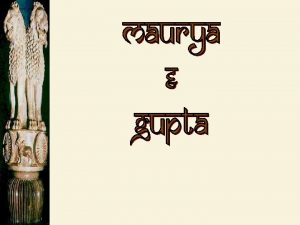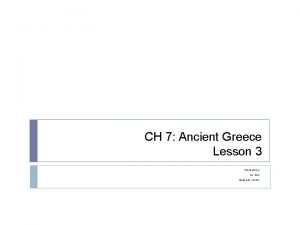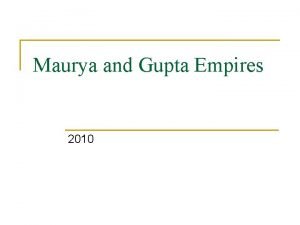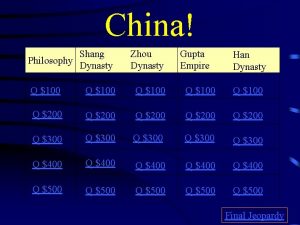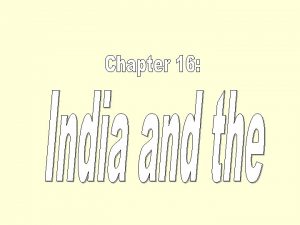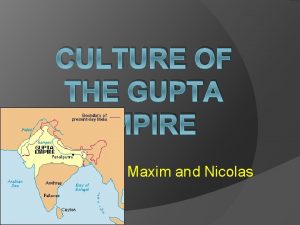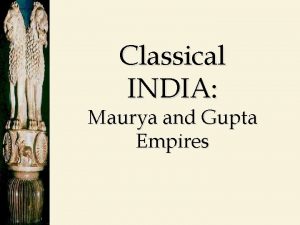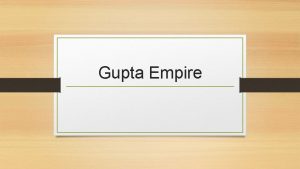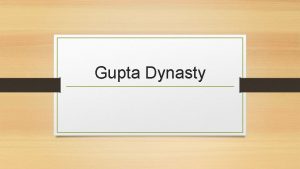The Gupta Empire Life Rulers and Land The









- Slides: 9

The Gupta Empire Life, Rulers and Land

The Gupta Empire existed at the same time as the Roman Empire. While we cannot say for sure, the two probably knew of each other. The Gupta Empire covered about two thirds of modern India and parts of modern day Pakistan, Nepal, and Bangladesh. The Gupta empire lasted from about 320 CE to about 500 CE. It dominated northern India.

People were for the most part safe and prosperous during the Gupta period. It is called the "Golden Age" of ancient India because of that peace and prosperity. The people had religious freedom. Hinduism spread, and was clearly the preferred religion, but Buddhism flourished as well. The empire provided simple health care for free. Writers, artists and musicians were paid to produce their art. Most people were not educated, but the higher castes were, and the universities of Gupta were so famous that scholars from China came there to learn.

The Gupta Empire provided each village with a military squad to protect them. The squads, which were supported by the village, were also part of the royal army. During times of war, the local squads all drew together to make up the royal army. A typical squad consisted of an elephant, a horse drawn chariot, three calvary men and five foot soldiers. It doesn't sound like much when you look at one village at a time, but together, village squads formed a powerful army.

Everyday Life under the Gupta Empire The typical house during the time of the Gupta empire was made of bamboo or wood with a thatched roof. Many homes had only one room, although two rooms or more were not uncommon. Even the nobles and kings lived in wooden houses and palaces. A Gupta village was a noisy place. The streets were narrow with houses on both sides and businesses set up in stalls in the street. People and animals both wandered through it. The smell of cooking filled the air as food vendors sold their wares.

Types of Work Craftsmen practiced their arts in the villages and worked in iron and copper. Their iron was of such quality that statues from them exist today with very little rust. Artists produced great works of literature, but sculpture was what they did best. Most people were farmers and wheat was the main crop, but they did keep cows for milk. Besides their normal daily jobs, people were expected to work for the king or ruler every year for a period of time. But unlike other places, the people of the Gupta period were paid for their time. They might work on building or fixing roads, or digging and dredging canals. It was work that benefited all of the people.

Math and Food The Gupta empire did not have banks like we do today. In some areas the women wore the family fortune as jewelry. Gupta mathematicians and scientists were quite accomplished. They figured out that the earth revolved around the sun and computed the exact length of a year. They also invented the base 10 math system we use today, and invented the decimal point to measure sums less than one. In the earlier part of the Gupta empire, meals were both vegetarian and non-vegetarian. With the rise of Buddhism, vegetarian meals became the norm for about one half of the people. They grew and ate the various grains as both cereals and breads, with many different types of vegetables, fruits and nuts. They also drank milk from cows and goats.

School and Marriage Some children did go to school. These schools were called Ashrams. In the ashram, there were no servants. You had to do everything for yourself. Children studied math, science, literature, music and religion, as well as learning how to read and write. Some also learned how to take care of themselves by cooking, cleaning and washing clothes. In the Gupta empire, there were three different types of marriage. Swayamvara was when the bride selected her spouse from a group of young men gathered outside her house. Gandharva Vivaha was the love marriage. Asura Vivaha was marriage by abduction (elopement). Some marriages were arranged by the parents, but this was unusual and mostly occurred within the Nobles.

Fun and Clothes One of the greatest games of all time was invented by the Indians: chess. The people of India also invented playing cards. Their cards are not like the ones we have today, but they were definitely playing cards. They, like most ancient people, also loved outdoor activities. They had martial arts and wrestling, and the nobility liked polo and hunting. They also kept birds as pets. Parrots were especially popular. The people of ancient India wore some of the same garments that are worn in India today. In the north, the dhoti was popular. This was a very long cloth that was draped around the lower body and legs and tied at the waist. In the south, the women wore a sari. A sari is a long piece of cloth that is wrapped around both the upper and lower body. When worn correctly it is very elegant.
